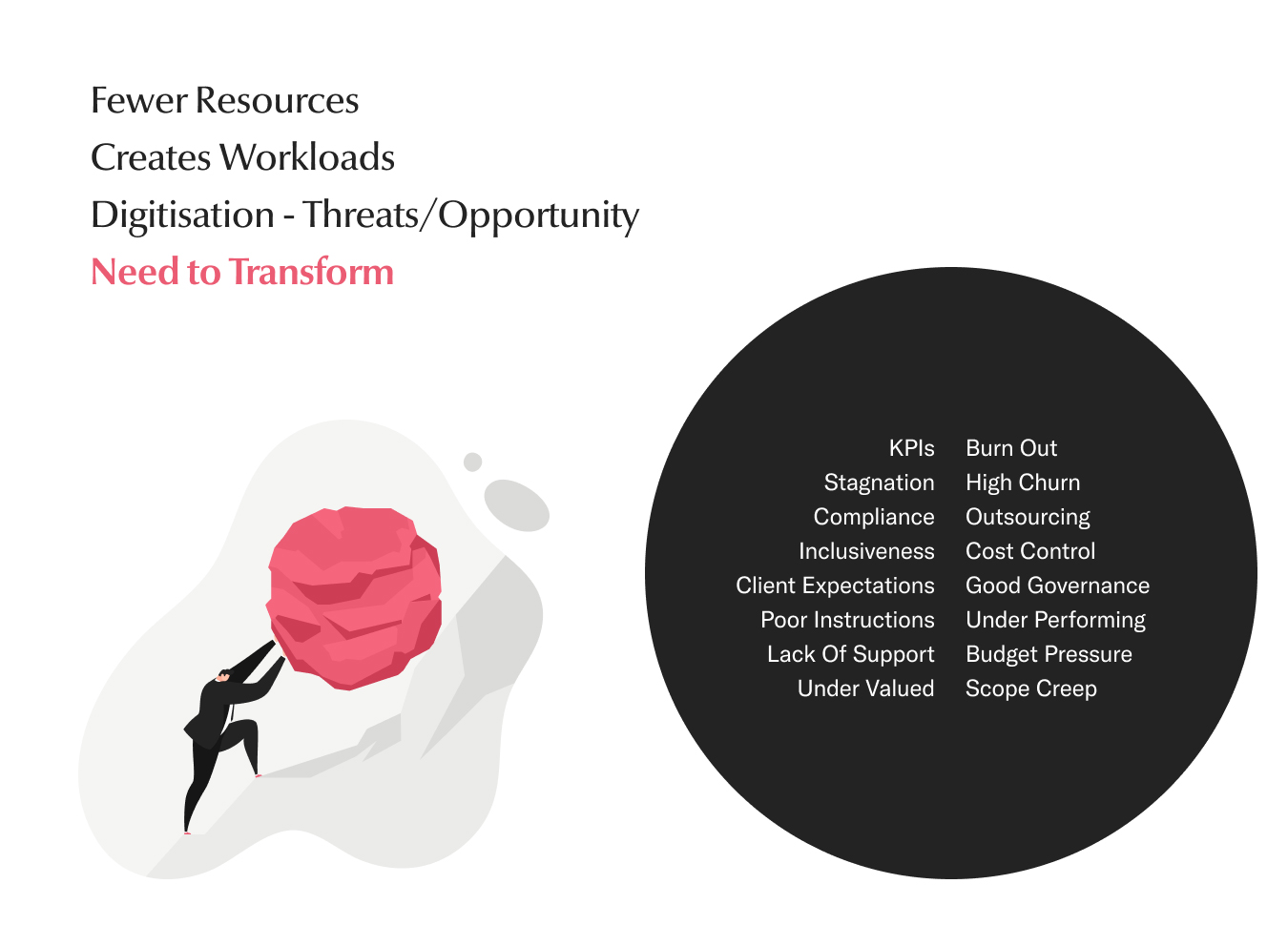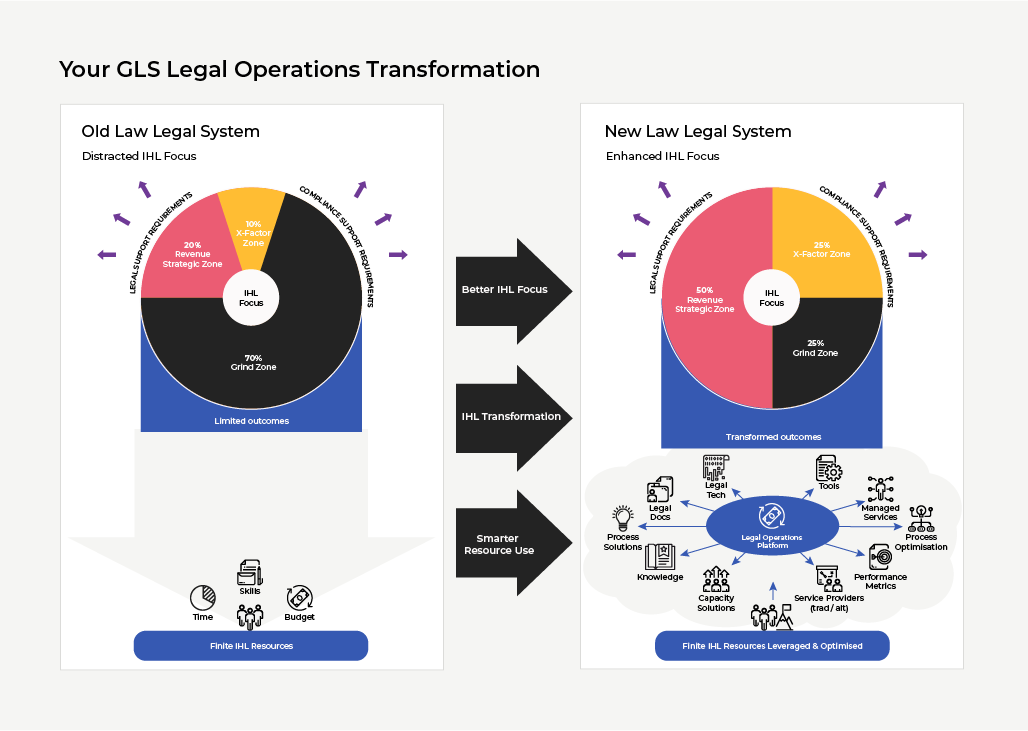GLS’s Ultimate Guide to Legal Operations

INTRODUCTION
We’re giving away this revolutionary guide to improving In-House Team Performance. Matthew Glynn, Director of GLS, outlines the path to optimization in 13 logical chapters. The first chapter is outlined below as the first step to optimization. Download the complete copy below to carry on your journey to IHL transformation success.
GLS's Ultimate Guide to Legal Operations - Introductions
“All in-house legal teams must accept that IHL Transformation is not a “job on top of the job” – it is a big part of “the job”! Being too busy to formulate your IHL Transformation agenda will simply no longer cut it – perpetual transformation is the IHL job."
01
Part A: Stepping Up The IHL Game
"Globally, many in-house legal departments ("IHLs") struggle to meet the rapidly growing legal and compliance requirements of the businesses they serve, whilst they are simultaneously being asked to reduce costs and demonstrate more value."
Do you know any in-house lawyer that would disagree with the statement above? We don’t
and we communicate with more than 10,000 in house lawyers multiple times each month.
One thing is for certain, the way in which IHLs operate needs to adapt – or to be more precise, IHLs need to
rise to the challenge of demonstrably achieving “far more with far less”.
The future for all IHLs is about evolving into teams that can achieve manifestly more with the resources
that they have at their disposal – this process is what we call: “IHL Transformation”.
(See Part C: The Case for Legal Operations)
Stepping Up The IHL Game

02
Part B:The Move to IHL Transformation
IHL Transformation is the management, deconstruction and re-imagining of how IHLs work so that the “business as usual” (“BAU”) is executed far more efficiently.
This competence gives far greater capacity for strategic and “business enabling” contributions. (see Part B: What is meant by “legal operations”?) For IHL leaders, typically experts in the law and department management (i.e. the “Old Law” structures), imagining how technology, data analytics, business process engineering and Millennials might aid IHL Transformation (i.e. “New Law” considerations), is not always easy. As such, the full Guide seeks to provide a holistic overview of how the domain of legal operations works, and new awys of thinking. (see Part C: The Case for Legal Operations & Part J: Essential Legal Operations Thinking). Moreover, it introduces tools, processes and “coal face” lessons that will help you make your IHL Transformation process far more manageable and efficient. This diagram depicts what is the goal of this deconstruction and re-imagining of your IHL. The journey to get there is your own unique IHL Transformation. (See Part G: Preparing your Legal Operations Agenda)

To start that journey, all that is required is the knowledge of how to effectively and efficiently formulate an IHL Transformation plan and implement it - something that we hope to share with you in abundance in the Guide. Fortunately, for those IHL leaders eager to undertake an IHL Transformation, the challenge is not nearly as great as it might appear at first glance given:
Systemic Inefficiencies:
Much legal industry activity has historically been conducted in such an inefficient fashion that achieving massive productivity gains from existing resources is actually not that difficult.
Legal Innovation:
We all now operate in an environment that offers a steady stream of new technologies and innovations that increasingly make substantially elevated IHL performance imminently feasible.
Self Authorship:
Self-authored change is always more effective – few will know your business and all of its foibles as well as you - and your proactive efforts will be recognised as “initiative”, not corrective action imposed from above.
03
Part C: Obstacles to IHL Change
Whilst the case for profound change in the legal industry has been overwhelming for well over a decade, our industry has always proved stubbornly change averse.

This generally holds true whether you are an in-house lawyer or in private
practice. (see, amongst others, Part K: 10 Things That Can Sink Your Legal Operations
Agenda) The obstacles to change within the IHL community, whilst nowhere near as acute as they are
in private practice, are largely centered around the same issues - outdated practices and mindsets, and
leadership with vested interests. (see Part J: Essential Legal Operations Thinking)
Unlike any other industry, the legal industry has generally been rewarded for saying “no” to new
efficiency-based initiatives. The vested few best served by “old ways” might say “don’t fix what isn’t
broken”. Newsflash – it is broken!
Consider this: what would you make of the farmer that uses hundreds of men with shovels to dig a field
instead of hiring in an earth mover for a couple of hours? Would you celebrate their wisdom or question
their sanity?
As an example, the reluctance to professionalise external legal procurement is one of many examples of the
millstones of old-guard IHL leadership. Why has legal procurement proven immune to the global best practices
applied by all other procurement functions?
So change it will be...
The global business community desperately needs its IHLs to do far more now than
ever before, but sadly the discussion prioritises containment of IHL costs and not enhanced productivity. As
such, the IHL community must focus on EFFICIENCY and rapidly catch-up with the rest of the business
community.
Increasingly, IHLs are being viewed just like “any other department” and are no longer immune from
organisation-wide rationalisation and /or efficiency programs/audits. As The American Lawyer notes “today’s
general counsel are being asked to think like business leaders, not just lawyers.” In this context –
“self-authored” change is clearly preferable.
(see Part C: The Case For Legal Operations)
Fortunately, unlike the private practice community, there is no economic incentive binding IHLs to past
inefficiencies – the IHL community is far more amenable to change, and is far more aligned with its client
(i.e. the business) that demands it.
Imminent danger lurks for IHL leaders claiming to be "too busy with the day-to-day to find time to plan".
Such leaders will find themselves falling further behind "peer" departments and competitors that have
deliberate plans to focus resources and effort. (See Part E: The IHL Leadership
dilemma)
So, change it is – either voluntarily, because you know that it is the only way forward – or mandatorily,
because it is forced upon you by a business that demands that every business unit demonstrate value and cost
savings.
04
Part D: Green Shoots Of New IHL Leadership
It is often said that “time fixes everything” – and it will be time that plays a big part in re-charting each IHL course to a much better destination and re-defining highly elevated and verifiable levels of IHL performance.

Demographics are now a key driver for IHL innovation and adoption of legal technology, as “Millennials”
increasingly assume IHL control - accepting “this is the way we have always done it” is simply no longer
an option.
The new generation of IHL leaders are all about clearing away the “white noise” that keeps their IHL
from making a positive difference to their business - from working on what is strategic and of true
value.
This new breed of IHL lawyer does not need to be convinced of the value that legal
technology can bring to operational efficiency – they expect it to be deployed and that it performs like all
of the consumer technology they’ve used since birth.
There are increasingly loud voices (e.g. Daniel Linna, professor director of LegalRnD at Michigan State
University) pushing for “legal innovation” to be taught at law schools. IHL Millennials in particular, are
ready to embrace the changes needed to not just survive in practice but to thrive and make a truly
meaningful impact, because it has never been easier to do so – and it is just
what they do.
This is what this Guide is about (see Part D: Effective Legal Operations) and this
Guide is written for those in-house lawyers who want to effect profoundly positive change at atime when
transformation is imminently possible.
05
Part E: Transformation Is Now The New Day Job
All IHLs must accept that IHL Transformation is not a “job on top of the job” – it is a big part of “the
job”! Being too busy to formulate your IHL Transformation agenda will simply no longer cut it – perpetual
transformation is the IHL job.
A key attribute of the New Law IHL is the ability to make sense/use of a constant stream of innovations and
new technologies that deliver substantially elevated IHL performance levels and which then quickly become
“the norm”.
The “transformation wheel” need not be re-invented for each and every IHL, IHLs need only be
aware that new wheels are being invented every day that can help them achieve better, faster, cheaper and
safer operations.
New Law IHLs must therefore embrace the implementation of a regular flow of innovation – and
bring it all together to deliver constant and empirically verifiable performance improvements. (see, amongst others, Part I: The Role Of IHL Performance Analytics)
06
Part F: The Questions This Guide Answers
First and foremost, this Guide helps IHLs understand that the IHL Transformation process need not be an overwhelming endeavour and that there are ready answers to fundamental questions such as:

- How do you make your existing resources perform better?
- How do you objectively assess your current performance?
- What does an optimised legal function look like?
- How can a legal operations focus bring about rapid and fundamentally positive change?
- Where should I start my transformation efforts?
- How do I establish what my priorities should be?
- Is there a logical implementation order for successful transformations?
- How can performance data help my team?
- How can I prevent avoidable missteps?
- How should I approach transformation decision making?
- How can I access the non-legal skills and experience needed to effectively transform?
07
Part G: The GLS Legal Transformation Tube Map
Critically, this Guide also introduces you to the GLS Legal Transformation Tube Map,
which is a powerful visualisation of an optimally performing IHL team that you can use as a reference to
guide your own transformation journey.
The GLS Legal Transformation Tube Map (see Part F: The Interactive GLS Legal
Transformation Tube Map) is an interactive tool and the most comprehensive depiction of the critical
elements of a high performance IHL that has, as far as we can tell, ever been made available publicly. It
is, even if we do say so ourselves, ground-breaking!
By being able to see the “entire” picture in granular detail IHL leaders can access a deep array of insights
into the current performance levels of their IHL and readily locate efficient focal points for improvement.
(See Part H: The Legal Operations - Powerful First Steps)
The GLS Legal Transformation Tube Map breaks down the transformation process and its attendant complexities
in a way that allows IHLs to visualise, plan and self-author, for their own IHL Transformation journey
meaningful and verifiable goals.
08
Part H: Focus on Demostrable Outcomes
The full guide explores how IHLs can utilise performance metrics to better demonstrate their value contribution to their business, and create a more powerful platform from which to operate and let their value recognition grow. (see Part I: The Role Of IHL Performance Analytics).
Performance metrics are becoming critical to every IHL– the objective being to translate the department's
goals into measurable units that demonstrate progress and improvement – just like most other business
departments.
Simply put, IHLs who succeed in ingraining quantifiable performance management tools into their day-to-day
operations will produce impressive short and long- term results. So this Guide unpacks the fundamentals of
IHL performance metrics (see Part I: The Role Of IHL Performance Analytics).
This Guide will introduce you to a fertile source of performance data, a range of common performance
metrics, and demonstrate the enormous insights available to IHL teams that take some simple and small steps
to utilise that data.
09
Part I: GLS Legal Operations
The full guide explores how IHLs can utilise performance metrics to better demonstrate their value contribution to their business, and create a more powerful platform from which to operate and let their value recognition grow. (see Part I: The Role Of IHL Performance Analytics).

You can access 300+ tools, solutions and resources that can support everything from a “one off IHL performance project” all the way through to an entire “IHL overhaul”. Throughout the Guide, references will be made to resources that are available to help you efficiently implement your transformation plan – this includes free tools, informative white papers and free trial solutions etc.
10
Part J: Embracing Legal Operations
IHL leaders must realise that "legal operations" is not just about cost cutting and reporting metrics - it represents an opportunity to elevate the reputation of an IHL within its organisation, and to enable that IHL to work more strategically and effectively.
This opportunity can only be fully seized if i) the IHL Transformation plan is properly
framed within the
context of the specific organisation, and ii) the goals of that transformation is properly communicated to
the organisation. (see Part G: Embracing your Legal Operations Agenda)
To help IHLs deliver the correct messaging, this Guide communicates the foundational aspects of “legal
operations” and has a particular focus on i) how to successfully implement legal operations into your IHL,
and iii) the benefits of doing so.
11
Part K: The IHL Future – Exciting Times
The future of the IHL community is about stepping up and providing unprecedented leadership – which is increasingly possible if we use “legal operations” as a strategic tool to put into place a proper platform for IHL leadership.
IHLs must respond to recent global Covid-19 turbulence and navigate their businesses
into new markets, products and deals, whilst guarding against poor decision making by panicked business
leaders and bureaucrats.
Perhaps the IHL community, with all of its power (it controls 60%+ of the revenue of law firms), can demand
change that can address this challenge.
Mark Cohen notes that indeed, IHLs are increasingly seeking alternatives to law firms expect for a “narrow
band of high-value matters that remain predominately sourced to… ‘law’s one percent’.”
At the same time, IHLs must help address the biggest failing of the legal industry to date - the fact that
most businesses have no consistent access to external legal support at all – something traditional law firms
rarely feel is a problem worth solving. (see Part L: Global Legal Operations
Communities).
In the context of such abundant need, it is hard not to argue that the importance of the IHL community will
grow manifestly in the years to come. For those with the correct perspective – it has never been a better
time to be an in-house lawyer.

12
Part L: The GLS Legal Operations Community
Finally, as you may have realised, the realm of legal operations, despite its transformative capabilities, is nascent outside of North America – something that we at the GLS Group are trying hard to address.
We hope you find this Guide useful enough, and legal operations appealing enough, that
you join our
growing legal operations community across Asia Pacific, Europe, Middle East and Africa so that we can
together address the challenges faced by IHLs globally.
We are not the only people with good ideas but we excel at working with great ideas and getting them to
those that need them – so, let’s work together – there is plenty to do.
